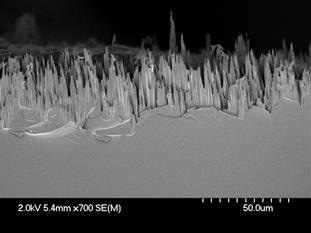Certain materials employed in aerospace applications, like polymers, can erode and degrade upon prolonged exposure to ultraviolet radiation, atomic oxygen and extreme temperature cycling found in outer space.
 Erosive effect of the combined action of atomic oxygen and UV radiation on a hard polymer sample mounted at the leading edge of the International Space Station. Image Credit: University of Illinois.
Erosive effect of the combined action of atomic oxygen and UV radiation on a hard polymer sample mounted at the leading edge of the International Space Station. Image Credit: University of Illinois.
Orbiting spacecraft, such as the International Space Station, travel at around 18,000 miles per hour, and the micrometeoroids and other space debris pose a severe threat to the integrity of lightweight space structures made of polymers and their composites.
Various labs at the University of Illinois Urbana-Champaign collaborated to address this problem and came out with self-healing materials made of specially designed microparticles and nanoparticles, offering a more durable solution for space structures. The first of its kind, these self-healing materials are sent into orbit for testing at the ISS National Laboratory.
The materials we use are novel nanocomposites, based on thermosetting polydicyclopentadiene (pDCPD)-matrix mixed with self-healing components, which can be cured in a matter of minutes to hours compared to traditional thermosetting polymers that take days to cure inside an autoclave.
Debashish Das, Postdoctoral Scholar, Department of Aerospace Engineering, University of Illinois Urbana-Champaign
“Also, these novel pDCPD-based materials are amenable to additive manufacturing techniques with the potential for rapid fabrication or repair of parts right where they are in space,” added Das.
The Air Force Office for Scientific Research and the ISS National Lab financially support professors Nancy Sottos and Ioannis Chasiotis to create samples that can be mounted facing three different directions on the ISS. Each side of the ISS is subjected to conditions with varying amounts of ultraviolet radiation and atomic oxygen — ram, in the direction of travel; zenith, facing away from the Earth; and wake, in the trailing direction.
Conducting experiments in space is very expensive; therefore, the researchers created samples about the size of the eraser on top of a pencil. A total of 27 samples was fixed to three plates, each of them measuring one inch square. Exposure to the space environment was achieved by a window over each sample.
Eric Alpine, Aerospace graduate student, and AE faculty Michael Lembeck utilized their facilities in the Talbot Laboratory to analyze the volatile content in the samples to be exposed to space. The researchers baked the samples under a high vacuum at 176 °F for 24 hours to simulate accelerated space conditions. The loss in mass of all the samples was well within the acceptable limit permitted by NASA.
Kelly Chang, a Materials Science and Engineering PhD student, and postdoctoral scholar Mayank Garg, in the Autonomous Materials Systems Group at the Beckman Institute, created the self-healing approaches and fabricated all of the samples.
Based on a prior experiment at the ISS by Professor Chasiotis’ group, we know that embedding glass nanoparticles in all of the samples will improve the erosion resistance. In Professor Nancy Sottos’ group, we have been experimenting with a more active mechanism for resisting erosion damage.
Kelly Chang, PhD Student, Materials Science and Engineering, Beckman Institute
“We embedded microcapsules, holding active materials that are triggered when the atomic oxygen in space ruptures the capsules and allows the liquid core of these capsules to react,” added Chang.
Chang further noted that there are samples that do not contain the capsules and which would serve as controls for later experiments. The samples also contained standard aerospace-grade epoxy for comparison.
According to Das, the success of these self-healing polymers in space will be a great boost for manufacturing in outer space. “That’s a long-term goal, to be manufactured in space,” he added.
If our hypothesis that these novel materials resist erosion for a longer period compared to epoxy-based materials stands, then we will have an alternative to epoxy-dominated markets for space, as well as earth-based applications.
Mayank Garg, Postdoctoral Scholar, Autonomous Materials Systems Group, Beckman Institute